CLINICIAN'S CAPSULE
What is known about the topic?
Little is known about attendance at outpatient specialized geriatric services following recommendation by geriatric emergency management nurses in the emergency department (ED).
What did this study ask?
The study sought to examine adherence to outpatient evaluations, including barriers and facilitators to attendance.
What did this study find?
Both acceptance of and adherence to outpatient specialized geriatric services in older ED patients are suboptimal.
Why does this study matter to clinicians?
Non-adherence with recommended evaluations increases the risk of poor outcomes in patients in whom geriatric syndromes are not addressed.
INTRODUCTION
Older persons are the highest users of the emergency department (ED), with increasingly complex needs that are poorly suited for optimal care in the busy ED environment.Reference Latham and Ackroyd-Stolarz1 In an effort to enhance care, a geriatric emergency management (GEM) practice model has been adopted by many large EDs.Reference Flynn, Jennings and Moghabghab2 In this model, high-risk older patients are assessed in the ED by specialized GEM nurses who perform targeted geriatric assessments. High-risk patients are those who are thought to be at increased risk of functional decline, repeat ED visits, and future hospitalization.Reference McCusker, Bellavance and Cardin3 Often these targeted GEM assessments identify geriatric syndromes, and recommendations are made for support services and further specialized geriatric services (SGS) in the community.
Adherence to outpatient evaluations is an important consideration for emergency physicians attempting to develop safe and appropriate disposition plans. Previous work amongst Canadian centres has shown good adherence to recommendations for outpatient specialty evaluations.Reference Friedman, Vergel de Dios and Hanneman4–Reference Murray and LeBlanc6 Little work has been done to specifically examine the adherence in geriatric populations and describe any factors that may impact adherence. As more resources are allocated to facilitate the care of this high-risk population, it is important that we characterize the utilization of these interventions. Failure of patients to comply with community-based follow-up leads to resource waste, increases the risk of poor outcomes in patients in whom geriatric syndromes are not addressed, and precludes us from later examining the efficacy of these resource intensive assessments.
The objective of the current study is to 1) evaluate the adherence of older ED patients to recommendations for further outpatient SGS as recommended by the GEM team, and (2) characterize barriers and facilitators to attendance, with the overall goal of improving the transition of care from the ED to the community in this vulnerable population.
METHODS
Design and setting
We conducted a prospective observational cohort study at two sites of an academic, tertiary level hospital ED with combined annual visits of 170,000 in Ottawa, Ontario, between July and December 2016.
The GEM program
The GEM program was implemented in 2007 at the Ottawa Hospital to enhance the care of seniors in the ED who are at high risk of increased hospital utilization. The GEM program consists of emergency nurses with additional training in geriatrics. The service is available daily during business hours, with telephone follow-up available for eligible patients presenting outside of this time frame.
Patients may be referred to GEM by an ED physician or nurse, or through a two-phase administrative screen. The first part of the administrative screen captures patients presenting to the ED who are ≥ 75 years of age, a resident in the local health network, not currently in long-term care, who have a previous ED visit within the last 6 months, and triaged as Canadian Triage and Acuity Scale 3, 4, or 5. Patients identified through the first phase then underwent screening with the Identification of Seniors at Risk (ISAR) tool.Reference McCusker, Bellavance and Cardin3 The ISAR is a validated tool designed to identify seniors who may benefit from a targeted assessment.
Once a referral to GEM has been made, the GEM nurse performs a focused geriatric assessment targeting cognition, mood, mobility, home function, and caregiver issues, in addition to other geriatric giants. Recommendations are made based on the specific needs of the patient and often include a referral to SGS.
Study population
We included a convenience sample of ED patients, 65 years and older, who underwent assessment by the GEM nurse and were referred for further outpatient evaluation through various SGS. We included patients assessed by both a GEM nurse in person and a GEM nurse through a telephone consultation after ED discharge.
We excluded patients if they were assessed by the GEM nurse and not referred for outpatient specialized geriatric service evaluations, did not give consent, or were subsequently admitted to hospital. Patients were consented to study participation by the GEM nurse, if they met inclusion criteria following the completion of the GEM assessments.
Data collection
Patient demographic information was obtained through the electronic medical record. Information regarding patient experience with their GEM consultation and follow-up appointment was obtained through a structured telephone follow-up interview.
Patients were contacted by telephone approximately 6 weeks after their initial ED presentation and GEM consultation. At the time of consent, patients were able to specify whether they wished to be contacted or to have a family member contacted on their behalf. Phone call attempts were made to one household, that of the patient or a designated family member. If initial contact was unsuccessful, four further attempts were made to contact them, during daytime and evening hours, on both weekdays and weekends.
Patients were read a standardized prompt, reviewing study objectives and confirming their consent to study participation. If the patient remained agreeable to study participation, a structured telephone interview (Appendix) was then completed in a standardized format. Telephone interviews were completed with either the patient or a family member.
Outcome measures
The primary outcome was adherence to outpatient follow-up recommendations with specialized geriatric services. Adherence was determined by the proportion of patients that attended their recommended outpatient follow-up after accepting the referral in the ED. This did not include patients who declined referral for further evaluation in the ED. Outpatient follow-up recommendations were determined by analysing the GEM consultation note within the electronic records. Available specialized services included the GDH programs, the Geriatric Assessment Outreach Team (GAOT), Falls clinic, Geriatric Psychiatry Community Services of Ottawa (GPCSO), and Memory program.
The GDH provides comprehensive multidisciplinary assessment by a geriatrician and other allied healthcare professionals. In addition, short-term treatment, counseling, and education are available to patients and their caregivers to facilitate long-term care planning. The GAOT provides a focused geriatric assessment directly in the home of the patient by a nurse, occupational therapist, physiotherapist, or social worker with a focus on geriatric syndromes and in-home safety. The Falls clinic provides a multidisciplinary assessment with added emphasis on mobility and falls. GPCSO is an interdisciplinary service led by a geriatric psychiatrist with a focus on psychiatric concerns. The Memory program provides focused assessment for the diagnosis and treatment of dementia.
Secondary outcomes included patient satisfaction, and barriers and facilitators to adherence identified through our telephone follow-up. This was described both qualitatively and using a yes/no dichotomous scale. Our initial template included a five-point Likert scale; however, this was changed after initial interviews demonstrated that patients with cognitive and hearing impairments struggled with this more complicated format.
Data analyses
Simple descriptive statistics were used to determine adherence to outpatient evaluation, barriers, and facilitators to attendance and patient satisfaction. Means with standard deviations and proportions were used for continuous and categorical variables, respectively. A regression analysis was not performed given the small sample size of the present work.
RESULTS
Between July and December 2016, 823 targeted geriatric assessments were completed by the GEM nursing staff (Figure 1). These assessments identified 285 eligible participants, with 103 patients enrolled in the final study. Of eligible participants, 182 were excluded primarily because they declined the suggested referral to specialized services (86), or because consent for study participation was not obtained during the initial GEM assessment (86).
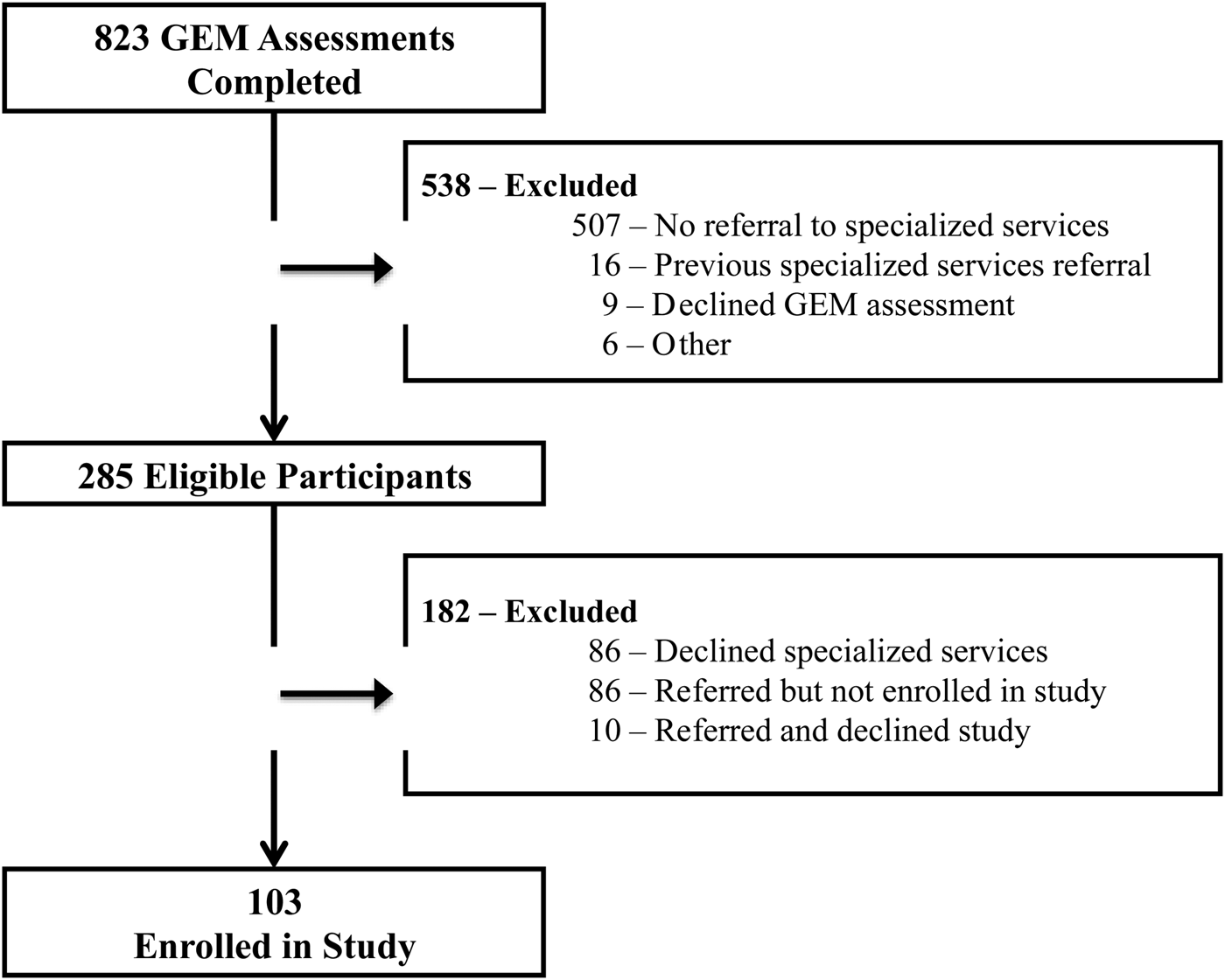
Figure 1. Study flow diagram.
Baseline characteristics of the enrolled patients are summarized in Table 1. The mean age of this population was 83.1 (SD ± 1.4) years, with 59.2% of the population being female. The majority of patients lived at home alone (40.8%) or with family (38.8%). Prescription medication burden for patients was high with the average patient taking 7.9 (+/-0.7) prescribed medications. Rate of cognitive impairment was high with 73.2% of patients being deemed impaired based on documented cognitive testing. Documented cognitive testing consisted largely of the Montreal Cognitive Assessment (MOCA)Reference Nasreddine, Phillips and Bedirian7 and Mini Mental Status Exam (MMSE),Reference Folstein, Folstein and McHugh8 and, in limited cases, the Ottawa 3DY ScaleReference Wilding, Eagles and Molnar9 and Mini-Cognitive Assessment (Mini-Cog).Reference Seitz, Chan and Newton10 Cognitive impairment was defined as a MOCA less than 26, MMSE less than 25, Ottawa 3DY less than 4, and Mini-Cog less than 3.
Table 1. Patient characteristics for 103 patients with specialized geriatric services referral
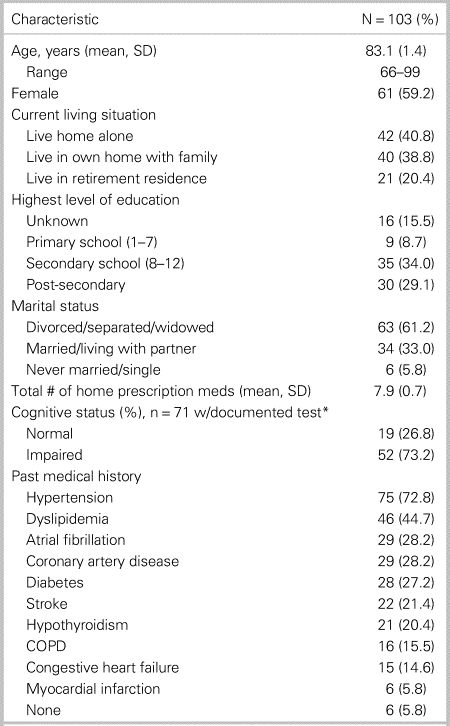
*Cognitive tests (score for impaired): MOCA (< 26), MMSE (< 25), Ottawa 3DY (< 4), Mini-Cog (< 3)
Table 2 summarizes the referral characteristics of the enrolled patients. The majority of patients were referred to the GEM nurse within the ED because of clinical concern from the bedside ED physician or nurse (71.8%). Following a GEM assessment, patients were referred for evaluation to specialized outpatient geriatric services for multiple geriatric syndromes, including mobility (86.4%), cognitive concerns (56.3%) and functional decline (39.8%). The most used SGS was the GDH program (48.6%), followed by the GAOT (26.2%).
Table 2. Referral characteristics of 103 patients referred to specialized geriatric services
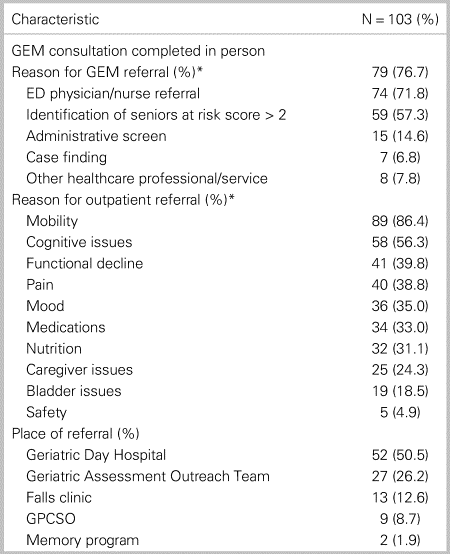
*Multiple reasons for referral.
Patients who agreed to a referral to SGS during their initial GEM evaluation in the ED were compliant and attended their recommended community-based evaluations in 59.2% of cases (Table 3). The GAOT (N = 25) had the highest rate of adherence at 81.5%, which is notably the only assessment completed directly in the home of the patient. This was followed by the GDH programs (N = 52) with an adherence of 57.7%. GPCSO had the lowest rate of adherence at 22.2%, primarily driven by long wait times, with many patients not having received a scheduled appointment at the time of study completion. If we consider adherence with GPCSO removed, the overall rate of appointment attendance increases to 62.8%.
Table 3. Adherence outcomes of 103 patients referred to specialized geriatric services
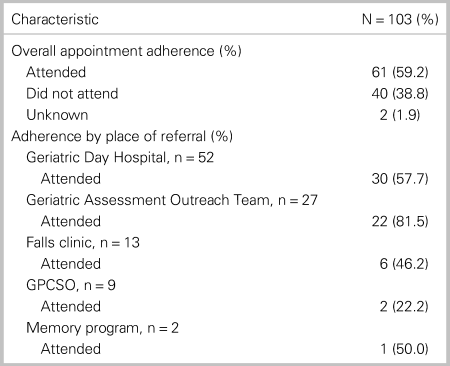
A structured telephone follow-up was completed with 71.8% of patients (Table 4), and 82.4% of those were completed with the patient directly. Only 53.4% of patients remembered their GEM assessment being completed in the ED, and only 52.1% of patients felt as though they would or did benefit from further outpatient evaluation. Amongst patients who were non-compliant, the most common cited reason was patient choice (40%); patients were often vague and did not give specific reasons for this. Many patients experienced transportation difficulties when attending appointments (45.2%), with the majority of patients being reliant on family/friends for both arranging appointments (53.4%) and transportation (72.6%).
Table 4. Telephone follow-up call data of 103 patients referred to specialized geriatric services
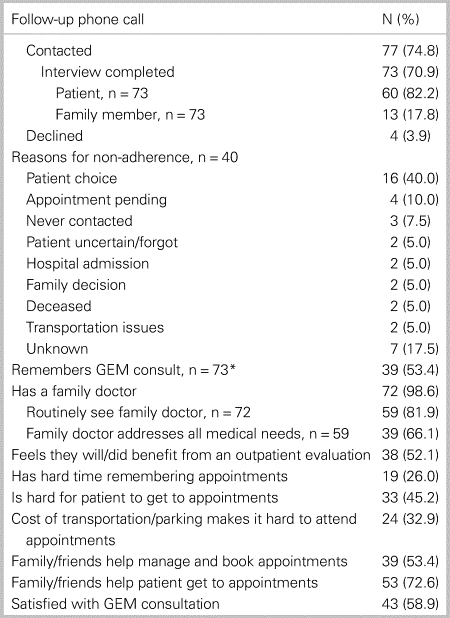
*n = 73 from this point onwards unless otherwise specified.
DISCUSSION
This is the first study to explore barriers and facilitators to attendance of outpatient SGS following evaluation by a GEM nurse in older ED patients. We found that overall adherence to follow-up recommendations was poor, with a key barrier being that many patients did not perceive value or need for further specialized geriatric assessments. Home-based assessments were identified as a facilitator to adherence and should be used when possible as part of appropriate disposition planning.
Comparison to existing literature
There is a paucity of evidence surrounding adherence to post-ED outpatient follow-up in the geriatric population. What little there is, is heterogeneous with respect to patient population, reasons for referral and places of referral; thus, it is difficult to draw meaningful conclusions. Denman et al. enrolled patients ≥ 65 years of age and reported an adherence rate of 87%.Reference Denman, Ettinger and Zarkin11 Guttman et al. reported an 8-day, self-reported adherence rate of 70% for follow-up appointments recommended by an ED-based nurse discharge planning program.Reference Guttman, Afilalo and Guttman12 McCusker et al. reported adherence rates of < 33% in their cohort of older patients with an ISAR score of >1.Reference McCusker, Dendukuri and Tousignant13 Our low adherence rate likely reflects that 1) our patients were high-risk (based on ISAR scores); 2) the majority had cognitive impairment; and 3) patients were referred to SGS. Our patients were screened using the ISAR, and by definition were high risk, compared with two of the studies,Reference Denman, Ettinger and Zarkin11,Reference Guttman, Afilalo and Guttman12 which did not target high-risk patients and included all persons age 65 years and older. In addition, although not described in detail, other studies included follow-up appointments to the patient's primary care practitioner, whereas our patients were referred to outpatient SGS. Older patients may be more willing to go to a physician with whom they already have an established relationship.Reference Wrede-Sach, Voigt and Diederichs-Egidi14 Older patients may feel threatened or intimidated if they feel their cognitive ability to drive and manage their own affairs is being evaluated, and thus less likely to be accepting of specialized geriatric evaluations.Reference Shipp and Penchansky15
To our knowledge, there is no published literature that examines barriers or facilitators to adherence to SGS following evaluation by a GEM team. Several studies have examined factors that influence adherence to ED recommendations, in general, with varying results. The existing literature suggests that failure to arrange appointment date prior to discharge,Reference Murray and LeBlanc6,Reference Richards, Meshkat and Chu16–Reference Komoroski, Graham and Kirby21 increased time from discharge to appointment date,Reference Magnusson, Hedges and Vanko22–Reference Field, Hedges and Arnold24 and poor understanding of discharge instructionsReference Friedman, Vergel de Dios and Hanneman4,Reference Engel, Buckley and Forth25,Reference Clarke, Friedman and Shi26 may impair patient adherence with ED follow-up recommendations. Hastings et al. found that a substantial number of geriatric ED patients had a poor understanding of their ED discharge instructions.Reference Hastings, Barrett and Weinberger27 The main barrier we identified was perceived lack of need for further evaluation. Many patients cited “patient choice” as their reason for failed adherence and were not able to provide more elaborate or well-articulated answers when questioned further during telephone follow-up. These findings, specific to the geriatric population, may explain why such a large proportion of older patients are not accepting of recommended referrals while still in the ED.
Strength and limitations
This study adds to the literature on adherence of older patients to outpatient follow-up following an ED visit. It provides valuable insight into barriers and facilitator to outpatient follow-up in the geriatric ED population. One of the strengths of this study lies in the prospective collection of data with good follow-up. However, the study is not without limitations. We are limited by a small sample size of a primarily urban geriatric population. In addition, the large number of patients declining initial referral in the ED was not anticipated, and thus the reasons patients decline ED referrals from the outset remain unclear. Finally, this study highlights the challenges of conducting telephone interviews with our elderly population. Over half of the patients interviewed could not recall their GEM assessment, and this is exacerbated by the high prevalence of cognitive impairment in this population. The poor recollection of these assessments makes it likely that our interviews suffer from recall and response bias, and precludes us from making an accurate interpretation of patient satisfaction.
Clinical and research implications
These results can help guide the disposition process for both ED physicians and members of the GEM team. The high level of cognitive impairment, lack of perceived value in further assessment, and reliance on family members in this population strongly highlight the importance for clear and open communication with both patient and family. Both the family and patient need to be aware of the trajectory and often downward spiral of the geriatric syndromes prevalent in this population.Reference Huang, Lee and Yang28 In addition, home-based assessments should be considered when available, because this was the key facilitator identified through this work.
This study evaluated adherence to community-based evaluations, but research is needed that describes the impact of these referrals: Do patients who are compliant to referral from the ED to specialized geriatric services have improved outcomes? An in-depth examination of barriers and facilitators to attendance at community-based evaluations is needed to inform targeted interventions to enhance adherence. Various strategies, shown to be effective in other patient populations, should be implemented and evaluated in the older ED population.Reference Guttman, Afilalo and Guttman12,Reference McCusker, Dendukuri and Tousignant13
CONCLUSION
Adherence of geriatric patients to outpatient specialized geriatric services is poor, with many patients outright declining referral to these evaluations prior to ED discharge. Future work should examine the adherence and efficacy of home-based assessments in a larger confirmatory setting, and focus on interventions to promote increased referral acceptance and address barriers to attendance.
Acknowledgements
We gratefully acknowledge the invaluable assistance of the geriatric emergency management nurses at the Ottawa Hospital for their assistance in patient recruitment. In addition, we thank Angela Marcantonio for her project assistance and My-Linh Tran for aiding in database management and statistical work.
Author contributions
Zachary MacDonald helped coordinate the study, collected the data, and contributed to the writing of the manuscript. Debra Eagles conceived the idea, coordinated the study, and contributed to the writing of the manuscript. Ioanna Genovezos assisted with data collection and manuscript revisions. Ian Stiell provided considerable assistance with study design and manuscript revisions. Zachary MacDonald had full access to all of the data in the study and takes responsibility for the integrity of the data and the accuracy of the data analysis.
Competing interests
None declared.
SUPPLEMENTARY MATERIAL
The supplementary material for this article can be found at https://doi.org/10.1017/cem.2019.376









